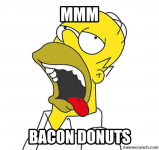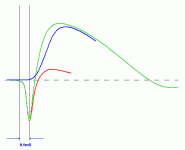No problem the 1/f nature of all physical processes is well documented and has been studied at length.
Pffrft! What are you ... on your phone!
Link some cool pics and charts like me!
Words mean ... meh
Pics, diagrams, charts, graphs, ...
Mmmm, graphs!

... It helps people understand how algorithms actually describe the world and how people ... decide.
Last edited:
Mmmm, graphs!
View attachment 678872
... It helps people understand how algorithms actually describe the world and how people ... decide.
Can't my favorite paper today. Why nature needs 1/f noise - IOPscience
Oh! you are such a tease!

"While ubiquitous at all levels of organization in nature, including in nanotechnology, low-frequency 1/f noise is not yet understood. A possible reason is the unjustified application of probability theory concepts, primarily that of independence, to random physical phenomena.
We show that in the framework of statistical mechanics, no medium can impart a definite diffusivity and mobility to a particle that performs random walk through it, which gives rise to flicker fluctuations in these properties.
A universal source of 1/f noise in many-particle systems in this example is a dependence of the time behavior of any particular relaxation or transport process on the details of the initial microstate of the system as a whole. "
Other
http://physics.princeton.edu/~mcdonald/examples/statistics/handel_pra_22_745_80.pdf
http://physics.princeton.edu/~mcdonald/examples/statistics/dutta_rmp_53_497_81.pdf
Doh!
Tee hee!
PS What I love so much, is that, once you up load it, it's there for ...

"While ubiquitous at all levels of organization in nature, including in nanotechnology, low-frequency 1/f noise is not yet understood. A possible reason is the unjustified application of probability theory concepts, primarily that of independence, to random physical phenomena.
We show that in the framework of statistical mechanics, no medium can impart a definite diffusivity and mobility to a particle that performs random walk through it, which gives rise to flicker fluctuations in these properties.
A universal source of 1/f noise in many-particle systems in this example is a dependence of the time behavior of any particular relaxation or transport process on the details of the initial microstate of the system as a whole. "
Other
http://physics.princeton.edu/~mcdonald/examples/statistics/handel_pra_22_745_80.pdf
http://physics.princeton.edu/~mcdonald/examples/statistics/dutta_rmp_53_497_81.pdf
Doh!
Tee hee!
PS What I love so much, is that, once you up load it, it's there for ...
Last edited:
Can't my favorite paper today. Why nature needs 1/f noise - IOPscience
I thought nature follows red noise https://vasseurlab.yale.edu/sites/default/files/2004_vasseur_yodzis_ecology.pdf 🙁
Learning about R,M,W operation, I didn't know. Not much "is" in near field, however with the dummy heads with ear mics placed at locations of people were at, then played back in stereo with head phones would recreate what they heard at the time...more than simple mics would.Don't forget that aural memory is very short than that memory recall is always a read, modify, write operation. In addition, gunshot noises in locations with effective reflective surfaces aren't in the near field.
It's probably too late now though.
While its been discussed we might as well define what Near-Field is and Near-field-monitoring, from the inventor himself, Ed Long. He wrote about it and some here have mentioned publications.
Anyway the first attachment is from Ed Long at CSI. And I think two other that are interesting.
Attachments
I thought nature follows red noise https://vasseurlab.yale.edu/sites/default/files/2004_vasseur_yodzis_ecology.pdf 🙁
Sadly Dimitri, it's only black and white.
I believe there was also a “baguette incident”It's as bad as the guy that left the empty Heineken can inside the LHC.
Ba da boom.
Only if you were using a general products hull.
Jn
If antimatter reacts opposite to gravity, no dark matter may be required to explain the big picture.
Pretty sure antimatter interacts with light/EM just fine, Paul. That's the trick of dark matter, no EM component.
I, once again, want to point out the innerfidelity.com website that Dimitri put up a few days ago. Looking around the website, I found further useful AUDIO info, like headphone frequency responses, as well as the Bob Katz Blog that is worth its weight in gold for people who want to know what true fidelity is.
Joe, if you're still here, I'm curious what it looks like when you play a sawtooth wave instead of a square wave? Sawtooth has twice the spectral components, I think the symmetry of square waves can be a bit of a confounder.
BTW, the initial tweeter impulse is backwards. So I know it looks like a square wave, but...
BTW, the initial tweeter impulse is backwards. So I know it looks like a square wave, but...
"All that stuff" was intended to be a correction...
I am not going to be enticed... 🙄
Joe, if you're still here, I'm curious what it looks like when you play a sawtooth wave instead of a square wave? Sawtooth has twice the spectral components, I think the symmetry of square waves can be a bit of a confounder.
Not sure what that would accomplish? What happens when you put a sawtooth waveform through a bandpass filter? What can it tell us that is of interest?
BTW, the initial tweeter impulse is backwards. So I know it looks like a square wave, but...

A tweeter with an infinite rise time would have all its usable output inverted, that 0.1mS would be eliminated and the tweeter's output inverted. The summed response, if you get it right, would look like the Green above. I have designed speakers where the tweeter has been electrically out of phase and yet acoustically invert everything below 22.5Khz. We have called this the 'Renegade Tweeter Theory.'
But it seems we are limited to what we are allowed to say about speakers on this forum. I think that is a shame, because there is a real need to look at the performance of amplifier and their interface with speakers, particularly with dynamic speakers that are essentially current devices and driven by amplifiers that are voltage sources. So the one thing that drives speakers is the very current of the amplifier, and we are using amplifiers that don't control the current, only the voltage.
So the output of the amplifier voltage wise is correct, that which we can see on an oscilloscope and can also measure all the usual distortions, which are all correct, because these tests are in the voltage domain. But the speaker care nought about the voltage, the F = Bl*i is what entirely determines the dB-SPL of the speaker - and there is no 'voltage' in that equation.
Now some will say that I am in the 'current drive' camp and I am definitely not.
So that area, of how the voltage of the amplifier satisfies the current needs of the speaker, this area is still somewhat of a fog, but one I hope is now gradually lifting.
But how can we then talk about amplifiers in isolation to speakers? Particularly when the one thing that conventional amplifiers cannot control (or 'regulate) is the very current that creates the sound with the kind of speakers most of us use?
Last edited:
Joe, May I ask about the purpose of posting over and over again about the same thing? Probably, pretty close to nobody else cares about the idea enough to do anything about it. If you want to move the concept into practical use, probably you will have to do it yourself and prove to the world that you have a better mousetrap. If you do, and it really starts to catch on then expect the bigger companies to try to beat you at your own game.
Also, I think we all understand that moving charge makes a magnetic field, and useful force comes from magnetic fields pushing and pulling on each other. But there is always voltage around the somewhere to push the current along in electromagnets. To point out that a particular equation doesn't include voltage among other things says that the equation presents only a limited picture of what must be going on.
Also, I think we all understand that moving charge makes a magnetic field, and useful force comes from magnetic fields pushing and pulling on each other. But there is always voltage around the somewhere to push the current along in electromagnets. To point out that a particular equation doesn't include voltage among other things says that the equation presents only a limited picture of what must be going on.
Well we could ask him to go back to basics and start with Lorenz...
Good luck.
I don't think anyone here is asserting that the optimal drive impedance for a speaker is zero ohms.
I also don't think anyone doubts that you can (in many cases) lower the harmonic distortion of a speaker using high drive impedance.
As far as I know, the idea that one can potentially make a better speaker using current drive, is obvious. Anyone with adequate study can go down the list of distortion sources and check off the ones that are helped by current drive. There are measurements to prove it.
I don't think anyone disagrees with even that.
So Joe, what is it really that you are arguing about?
I also don't think anyone doubts that you can (in many cases) lower the harmonic distortion of a speaker using high drive impedance.
As far as I know, the idea that one can potentially make a better speaker using current drive, is obvious. Anyone with adequate study can go down the list of distortion sources and check off the ones that are helped by current drive. There are measurements to prove it.
I don't think anyone disagrees with even that.
So Joe, what is it really that you are arguing about?
Hi Joe,
You are welcome to discuss speakers and how they are driven in their own thread. But if they are to be discussed, the discussion is to be open and factual. No secrets and no talking down to members who know this subject. It's the same with any topic, an open and honest discussion is fine. Of course it helps if a suspension of the laws of physics is not required.
-Chris
Sorry to interject here, but you know that this statement as it stands is simply not true.But it seems we are limited to what we are allowed to say about speakers on this forum. I think that is a shame, because there is a real need to look at the performance of amplifier and their interface with speakers, particularly with dynamic speakers that are essentially current devices and driven by amplifiers that are voltage sources. So the one thing that drives speakers is the very current of the amplifier, and we are using amplifiers that don't control the current, only the voltage.
You are welcome to discuss speakers and how they are driven in their own thread. But if they are to be discussed, the discussion is to be open and factual. No secrets and no talking down to members who know this subject. It's the same with any topic, an open and honest discussion is fine. Of course it helps if a suspension of the laws of physics is not required.
-Chris
- Status
- Not open for further replies.
- Home
- Member Areas
- The Lounge
- John Curl's Blowtorch preamplifier part III
